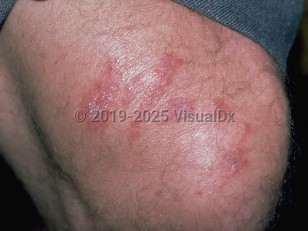Coral injury
Alerts and Notices
Important News & Links
Synopsis

Coral inhabits the tropical and subtropical waters of the world and consists of colonies of marine animals that have calcified outer skeletons. There are approximately 1,000 species of coral.
Accidental contact with coral often results in abrasions or superficial lacerations that are contaminated with small amounts of animal protein and calcium carbonate material. Some corals contain stinging cells (nematocysts), which can result in envenomation and more significant injury (see fire coral sting).
Superficial coral injury typically causes a stinging pain, erythema, pruritus, and a wheal at the wound site, called "coral poisoning." If properly treated, local symptoms may last a day or two. However, even with proper treatment, the wound may develop into a festering sore, ulcer, or cellulitis with lymphangitis that may take 3-6 weeks to heal. Chronic ulceration, necrosis, osteomyelitis, and lichenoid dermatitis may develop.
Low-grade fever in the absence of infection is not uncommon.
Accidental contact with coral often results in abrasions or superficial lacerations that are contaminated with small amounts of animal protein and calcium carbonate material. Some corals contain stinging cells (nematocysts), which can result in envenomation and more significant injury (see fire coral sting).
Superficial coral injury typically causes a stinging pain, erythema, pruritus, and a wheal at the wound site, called "coral poisoning." If properly treated, local symptoms may last a day or two. However, even with proper treatment, the wound may develop into a festering sore, ulcer, or cellulitis with lymphangitis that may take 3-6 weeks to heal. Chronic ulceration, necrosis, osteomyelitis, and lichenoid dermatitis may develop.
Low-grade fever in the absence of infection is not uncommon.
Codes
ICD10CM:
T63.691A – Toxic effect of contact with other venomous marine animals, accidental, initial encounter
SNOMEDCT:
238533000 – Coral injury
T63.691A – Toxic effect of contact with other venomous marine animals, accidental, initial encounter
SNOMEDCT:
238533000 – Coral injury
Look For
Subscription Required
Diagnostic Pearls
Subscription Required
Differential Diagnosis & Pitfalls

To perform a comparison, select diagnoses from the classic differential
Subscription Required
Best Tests
Subscription Required
Management Pearls
Subscription Required
Therapy
Subscription Required
References
Subscription Required
Last Updated:10/18/2017
Coral injury

